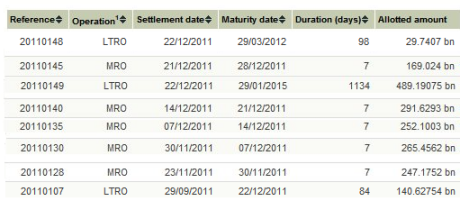So it seems Santa could only last one night.
Yesterday I said
…It may just be that banks end up using the facility to roll-over existing debt rather than using it to actively make new purchases.
Given that many of the European banks are attempting to de-leverage and simply hold higher levels of capital in order to meet their requirements under Basel III this makes sense. However, that doesn’t mean that the new LTRO along with the lower reserve requirements wouldn’t have some flow-on effect to bond markets, I am just not sure it is going to be used at the level and/or for the purpose the bond market seems to be suggesting. There are, however, some rumours out of Italy that suggest otherwise.
We will find out the answer to some of those questions tonight when the banks make a choice between the 7-day, 3-month or 3 year ( with a 12 month exit ) repo facility. A good uptake on the later should provide some support for all markets in the short term, at least until it is established exactly what the banks are doing with the facility.
When I said “short term” what I meant was something like a few days in which the market could determine, in the least, if the banks had simply parked the additional new money back into the ECB deposit facility or there were signs that they were using it to buy back their own bonds. However, it looks as though the market decided about one hour after the announcement that 523 banks had used the new 1134 day repo facility to the tune €489.19bn that this new money was going to be for re-capitalisation and de-leveraging operations.
Firstly a bit of clarity around the headline number. In the picture below I have taken the recently ending repo operations from the ECB’s open market operations history page. What you can see is that the banks significantly lowered their use of the shorter term facilities after the 3 year LTRO appeared.

It would seem that the banks have reduced their use of the 7-day MROs by €122.6bn and the 3-month LTRO by €110.9bn. It is also worth noting that on the long term facility’s page there is a note:
The allotment amount of EUR 489,190.75 million includes EUR 45,721.45 million that were moved from the 12-month LTRO allotted in October 2011
So if we deduct all of those numbers from the headline number what we actually find is that banks got €209.9bn. This is still a large number but considerably less than the headline. If you divide it by the number of banks involved it equates to an average of just over €400 million for each bank. Obviously some banks will get more and others less, but it does put the number into perspective when you see it that way. If an Australian bank raised an additional $400mil it certainly wouldn’t be headline news across the globe.
As I said above the outstanding question is exactly what the banks will do with this additional funds, on top of their other capital that is now available due to the lessening of the reserve requirements. Will banks take an interest in re-cycling that money through their sovereigns? If not then the new year’s sovereign bond market is probably going to be ugly. The movement on the Italian and Spanish yields last night may suggest that the market already thinks this is the case, but we will have to wait and see.
That opinion,however, was backed up by statements from the Italian banking association in a reversal of the rumour I linked yesterday.
While a lending crunch may have been avoided thanks to the ECB’s latest move, it is much less certain that banks will use the money to buy Italian and Spanish government debt, as French President Nicolas Sarkozy has urged, given the competing pressures on them to cut risk, rebuild capital and lend to business.
“While this might help to address recent signs of renewed tensions in credit markets and support bank lending, we remain skeptical of the idea that the operation will ease the sovereign debt crisis too,” said Jonathan Loynes, Chief European Economist at Capital Economics.
Banks will not increase their exposure to sovereign debt because European Bank Authority (EBA) rules discourage it, Italy’s banking association (ABI) said.
“The EBA rules are a deterrent for buying sovereign bonds, so not even the ECB’s important liquidity injection … can be used to support sovereign debt,” ABI director general Giovanni Sabatini told reporters.
It will also be interesting to see if the next LTRO operation gets as much interest. I noted yesterday that FTAlphaville had a short post on comments from the Bank of England minutes specifically around asset encumberance in securitised markets.
What’s really interesting is that the Bank of England seems to imply that the trend towards a collateralised lending framework is not sustainable. Specifically, they explain, there is a natural limit to this type of funding due to asset encumbrance.
When institutions run out of repo-able assets the funding environment can change sharply and quickly, especially with respect to the general availability of credit in the market place. Rates for normal households and businesses would simply soar.
I wonder if Europe could ever reach such a limit given the renewed ECB flexibility on repo operations.
As noted in today’s links, while all of the focus is on banking operations the real economy continues to stumble with Italian GDP contraction signalling recession:
The Italian economy contracted in the third quarter, signaling the country may have entered its fifth recession since 2001 as the government adopts new austerity measures that will further weigh on growth.
Lucky banks have got all that new capital…. They’re going to need it.